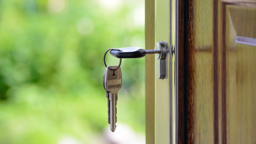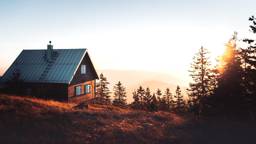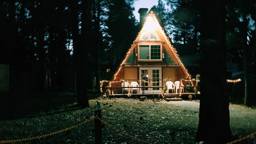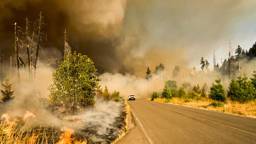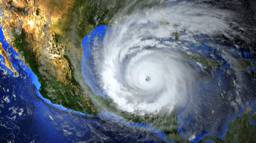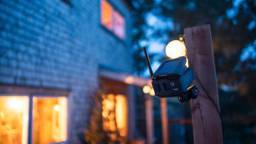Be Proactive in Protecting Your Place
Some cabin owners are reluctant to alter the canvas of their property by slicing down trees. But nobody advocates a clear-cut approach; besides, removing all trees would introduce other problems such as soil erosion.
“Would you really care that your dwelling was completely fire-resistant if it meant you had to live in a treeless environment? That’s not exactly aesthetic living,” says Michael Huff, fire protection consultant with Dudek, an environmental and engineering consulting corporation in Encinitas, Calif. “What you want is to come up with a workable compromise.”
Huff insists that it’s possible to take safety precautions and still keep a lush landscape. For instance, flammable plants with a high sap content – like evergreens and junipers – can be replaced by low-growing, fire-resistant plants with little sap content. Species recommended by the County of San Diego, Calif., include sycamore, maple, dogwood, oak, cottonwood, flowering plum and cherry trees. For a complete list of trees, shrubs and other plants appropriate for your area, see your local extension office or horticulturist.
“The goal is to break up the fuel continuity that extends from the wildlands right up to the house,” says Huff. “We want to do this both horizontally – from shrub to shrub, and vertically – from grass to shrub to tree.”
The multiple firestorms that engulfed southern California in October 2007 destroyed more than 2,000 homes, many of which had flammable vegetation surrounding their perimeters; this vegetation, in effect, carried the flames inside the structures.
Even little efforts by homeowners can make a big difference. Take the fire that started southwest of Lake Tahoe in June 2007 from an unattended campfire. That blaze destroyed over 250 homes; however, authorities estimate that three-fourths of those homes might have been saved had owners simply swept pine needles from their roofs.
Those few people who cleared hazards from their property essentially saved their homes, says Roger Jaegel, a retired forest service worker in California. “And those who did nothing were left with nothing.”
Some cabin owners are reluctant to alter the canvas of their property by slicing down trees. But nobody advocates a clear-cut approach; besides, removing all trees would introduce other problems such as soil erosion.
“Would you really care that your dwelling was completely fire-resistant if it meant you had to live in a treeless environment? That’s not exactly aesthetic living,” says Michael Huff, fire protection consultant with Dudek, an environmental and engineering consulting corporation in Encinitas, Calif. “What you want is to come up with a workable compromise.”
Huff insists that it’s possible to take safety precautions and still keep a lush landscape. For instance, flammable plants with a high sap content – like evergreens and junipers – can be replaced by low-growing, fire-resistant plants with little sap content. Species recommended by the County of San Diego, Calif., include sycamore, maple, dogwood, oak, cottonwood, flowering plum and cherry trees. For a complete list of trees, shrubs and other plants appropriate for your area, see your local extension office or horticulturist.
“The goal is to break up the fuel continuity that extends from the wildlands right up to the house,” says Huff. “We want to do this both horizontally – from shrub to shrub, and vertically – from grass to shrub to tree.”
The multiple firestorms that engulfed southern California in October 2007 destroyed more than 2,000 homes, many of which had flammable vegetation surrounding their perimeters; this vegetation, in effect, carried the flames inside the structures.
Even little efforts by homeowners can make a big difference. Take the fire that started southwest of Lake Tahoe in June 2007 from an unattended campfire. That blaze destroyed over 250 homes; however, authorities estimate that three-fourths of those homes might have been saved had owners simply swept pine needles from their roofs.
Those few people who cleared hazards from their property essentially saved their homes, says Roger Jaegel, a retired forest service worker in California. “And those who did nothing were left with nothing.”
Preparing for Unpredictability
Last spring, two devastating fires merged to become one massive mess. The first blaze started in April 2007 when a tree branch fell onto a power line near Waycross, Ga. Within two hours of hitting the ground, the inferno had spread nine miles. A few weeks later, a second fire ignited in the Okefenokee Swamp as a result of lightning; that fire later crossed into Florida. Ultimately the fierce flames burned 80,000 acres in the Okefenokee Swamp and surrounding forest, making it the largest wildfire in Georgia history.
“That fire was so crazy the way that it jumped and moved,” recalls Marty Via, the director of Brighter Days Ministries, Inc. in Blackshear, Ga. “Officials would announce that it was 90 percent contained and then 20 minutes later it would rage out of control again and it would be only 20 percent contained. Things changed just that fast.”
Martha and Buck Alverson of Waycross, Ga., were equally stunned by the fast-moving flames.
“When the fire started, we didn’t think much about it because it was on the other side of the county,” says Martha. “Then it started crossing county roads.”
Before they knew it, flames were lapping at their doorstep. But the Alversons – who live on a 2.5-acre farm with a house, a trailer and multiple barns – had taken some precautions by clearing the land ahead of time. Buck regularly disposed of leaves and dead brush that accumulated around the property.
When the flames finally flickered out, the Alversons felt lucky to have a home, though it was a bittersweet victory as they surveyed the scorched forest surrounding them.
“Everything around us was black,” says Martha. “It looked like an atomic bomb hit.”
Where Wildlands and Cabin Overlap
When human development sprawls into an area that was formerly wild habitat, this is known as the “wildland/urban interface.” As people have increasingly built vacation homes, or even primary homes, in the wildland/urban interface, insurance companies are looking closely at whether homeowners have done all they can to protect their investment. Therefore, whether you’ve freshly built or have lived in the same home for years, Tully Lehman, of the Insurance Information Network of California, recommends that homeowners ask their agent what kind of coverage is available in a particular area.
“Insurance rates are based on the information at hand,” explains Lehman. “If you’ve lived somewhere for 20 years, the risk may be higher now due to drought conditions or the fact that maybe an area has not had brush clearance done in awhile.”
Some cabin communities have formed Neighborhood Fire Watch/Firesafe Councils that meet to discuss what can be done – both individually and collectively – to reduce the potential for fire in a given area. This sort of community-level mentality is exactly what’s needed to make a nationwide difference in the number of structures that survive wildfires.
“There’s an awakening to the fact that each of us has a responsibility to take notice of the wildfire risks – and to take proactive measures to minimize those risks and protect our property,” says Lehman.
It’s something that the Liechtys of Montana figured out long ago.
“Cabin owners have to make choices,” Thorn Liechty says simply. “Sure, you can choose to leave that big, beautiful old tree that hangs over your home, but by doing so you’re accepting a risk. As for me and my wife, we’re going to do all we can to maximize the odds of our cabin’s survivability. We want to keep it around for a long, long time.”
Visit www.firewise.org to get more information.
Frequent contributor Christy Heitger finds that picking up sticks, branches, and leaves takes considerably longer when she enlists the help of her 4-year-old son Kyler, who prefers “throwing” to “collecting.”
Last spring, two devastating fires merged to become one massive mess. The first blaze started in April 2007 when a tree branch fell onto a power line near Waycross, Ga. Within two hours of hitting the ground, the inferno had spread nine miles. A few weeks later, a second fire ignited in the Okefenokee Swamp as a result of lightning; that fire later crossed into Florida. Ultimately the fierce flames burned 80,000 acres in the Okefenokee Swamp and surrounding forest, making it the largest wildfire in Georgia history.
“That fire was so crazy the way that it jumped and moved,” recalls Marty Via, the director of Brighter Days Ministries, Inc. in Blackshear, Ga. “Officials would announce that it was 90 percent contained and then 20 minutes later it would rage out of control again and it would be only 20 percent contained. Things changed just that fast.”
Martha and Buck Alverson of Waycross, Ga., were equally stunned by the fast-moving flames.
“When the fire started, we didn’t think much about it because it was on the other side of the county,” says Martha. “Then it started crossing county roads.”
Before they knew it, flames were lapping at their doorstep. But the Alversons – who live on a 2.5-acre farm with a house, a trailer and multiple barns – had taken some precautions by clearing the land ahead of time. Buck regularly disposed of leaves and dead brush that accumulated around the property.
When the flames finally flickered out, the Alversons felt lucky to have a home, though it was a bittersweet victory as they surveyed the scorched forest surrounding them.
“Everything around us was black,” says Martha. “It looked like an atomic bomb hit.”
Where Wildlands and Cabin Overlap
When human development sprawls into an area that was formerly wild habitat, this is known as the “wildland/urban interface.” As people have increasingly built vacation homes, or even primary homes, in the wildland/urban interface, insurance companies are looking closely at whether homeowners have done all they can to protect their investment. Therefore, whether you’ve freshly built or have lived in the same home for years, Tully Lehman, of the Insurance Information Network of California, recommends that homeowners ask their agent what kind of coverage is available in a particular area.
“Insurance rates are based on the information at hand,” explains Lehman. “If you’ve lived somewhere for 20 years, the risk may be higher now due to drought conditions or the fact that maybe an area has not had brush clearance done in awhile.”
Some cabin communities have formed Neighborhood Fire Watch/Firesafe Councils that meet to discuss what can be done – both individually and collectively – to reduce the potential for fire in a given area. This sort of community-level mentality is exactly what’s needed to make a nationwide difference in the number of structures that survive wildfires.
“There’s an awakening to the fact that each of us has a responsibility to take notice of the wildfire risks – and to take proactive measures to minimize those risks and protect our property,” says Lehman.
It’s something that the Liechtys of Montana figured out long ago.
“Cabin owners have to make choices,” Thorn Liechty says simply. “Sure, you can choose to leave that big, beautiful old tree that hangs over your home, but by doing so you’re accepting a risk. As for me and my wife, we’re going to do all we can to maximize the odds of our cabin’s survivability. We want to keep it around for a long, long time.”
Visit www.firewise.org to get more information.
Frequent contributor Christy Heitger finds that picking up sticks, branches, and leaves takes considerably longer when she enlists the help of her 4-year-old son Kyler, who prefers “throwing” to “collecting.”
Wildfires can ignite in any number of ways – a tossed cigarette, an unattended campfire, a lightning strike, a tree falling onto a power line. And they can pop up at any time of year, not just during the so-called “fire season.” Fires, unlike tornadoes, don’t tend to randomly pick off one house while leaving an adjacent one untouched. If you study the homes demolished by fire and compare them to those that were spared, you’ll likely see a pattern.
The owners of the cabins that were spared probably took preventative measures to help ensure that their homes would remain intact.
Don't Leave it to Fate
Thorn and Karen Liechty’s still-standing 2,500-square-foot cabin is proof that fire prevention measures actually work. In August 2007, the Liechtys survived a lightning-induced wildfire that not only jeopardized their 166 acres of forestland in Evaro, Montana, but also threatened to destroy over 200 homes in the area. However, because the couple had remained steadfast in their efforts to develop and maintain a defensible space (i.e., a buffer zone) around their property, they still have a cabin to call home.
Remember, fire will only burn when fuel is present, and fuel in its natural form consists of trees, bushes, grasses and vegetation. Therefore, by removing (or even diminishing) the fuel sources on their property, the Liechtys increased their cabin’s odds of survival.
“Our philosophy has always been to take the worst and leave the best,” says Karen. “We’ve annually cleared away the dead and dying trees. But we’ve always left a nice mosaic of Ponderosa pines and other trees on the property.”
The Liechtys have also regularly mowed the tall grasses; thinned the existing trees; disposed of needles, leaves and pine cones; and removed highly flammable vegetation from around their home’s perimeter. Why? Because they would rather
be safe than sorry.
“Folks tend to say, ‘Oh, look at those poor people out West!’ They never think that their home could be next,” says Karen. “But everyone needs to look at the houses that burned and ask themselves, ‘How does my structure compare?’”
The owners of the cabins that were spared probably took preventative measures to help ensure that their homes would remain intact.
Don't Leave it to Fate
Thorn and Karen Liechty’s still-standing 2,500-square-foot cabin is proof that fire prevention measures actually work. In August 2007, the Liechtys survived a lightning-induced wildfire that not only jeopardized their 166 acres of forestland in Evaro, Montana, but also threatened to destroy over 200 homes in the area. However, because the couple had remained steadfast in their efforts to develop and maintain a defensible space (i.e., a buffer zone) around their property, they still have a cabin to call home.
Remember, fire will only burn when fuel is present, and fuel in its natural form consists of trees, bushes, grasses and vegetation. Therefore, by removing (or even diminishing) the fuel sources on their property, the Liechtys increased their cabin’s odds of survival.
“Our philosophy has always been to take the worst and leave the best,” says Karen. “We’ve annually cleared away the dead and dying trees. But we’ve always left a nice mosaic of Ponderosa pines and other trees on the property.”
The Liechtys have also regularly mowed the tall grasses; thinned the existing trees; disposed of needles, leaves and pine cones; and removed highly flammable vegetation from around their home’s perimeter. Why? Because they would rather
be safe than sorry.
“Folks tend to say, ‘Oh, look at those poor people out West!’ They never think that their home could be next,” says Karen. “But everyone needs to look at the houses that burned and ask themselves, ‘How does my structure compare?’”
Sprinkler Sensation
In 1999, Minnesota’s Boundary Waters Canoe Area Wilderness (BWCAW)/Arrowhead region experienced a “blowdown” where high winds flattened a slew of trees in an area that spread across 477,000 acres.
“We knew with all of those dead trees on the forest floor there was a huge potential fire danger,” says Tony Faras, who owns a cabin on Seagull Lake, a border lake of the BWCAW.
Shortly after the blowdown, Tony and his wife Cindy installed a wildfire sprinkler protection system, which they used periodically each year as a preventative measure – dampening the vegetation when things were dry and wetting the ground during county-wide prescribed burns.
Unfortunately, the system’s true potential was tested in April 2007 when a massive wildfire roared into their cabin community. Named Minnesota’s most damaging wildfire since 1918, the blaze claimed over 75,000 acres and ravaged 160 structures – many of them belonging to neighbors of the Faras family.
During the large-scale evacuation from the area, Tony was afraid that his place was one of the casualties. But thanks to his wildfire sprinkler system, which sufficiently doused the property and created a dome of humidity around the house, neither the structure nor the adjacent trees burned.
He still vividly remembers the day he returned to inspect the damage. The stark contrast of vivid color against charred black was like stepping into the Wizard’s Emerald City.
“We came down our driveway and right around our home was a green oasis,” recalls Tony. “There was a distinct line of demarcation. You could see just how far the sprinkler heads reached.”
Making Good Choices
Installing a wildfire sprinkler system at your cabin is a smart move, especially for those in remote locations. But there are several things homeowners can do to “make or break” their cabin’s chance of surviving a wildfire. For instance, carefully considering your home’s construction materials is key. Choosing fire-resistant siding, using double-paned windows rather than single-pane windows, and placing 1/4-inch mesh on all vent grates and eaves (both in attic and crawl spaces) to keep embers out of the structure are all good choices. But perhaps the number one rule in construction is to avoid wooden roofs.
“It’s the worst thing you can do,” says Paul Summerfelt, a member of the Flagstaff, Ariz., Fire Department. “To install a wood roof is essentially pouring gasoline on your house.”
In Minnesota, Faras witnessed firsthand this costly mistake when one of his neighbors put a cedar shake roof on his cabin despite warnings from friends. Though he loved the look of his wooden roof, when fire swept through, his place quickly burned to the ground. Firefighter Summerfelt says that it’s these kinds of choices that can ultimately determine your cabin’s chance at survival.
“Firefighters don’t have the resources to save every house. We constantly have to make split-second decisions about which structures we’re going to try to save,” says Summerfelt. “We’ll bypass a cedar shake roof in a heartbeat because it’s a lost cause. So you see, homeowners can make our decisions for us if they don’t make wise choices.”
Another wise choice is ensuring that you have easy access to your place. Look at your driveway. Is it too narrow for a fire truck to turn around?
In 1999, Minnesota’s Boundary Waters Canoe Area Wilderness (BWCAW)/Arrowhead region experienced a “blowdown” where high winds flattened a slew of trees in an area that spread across 477,000 acres.
“We knew with all of those dead trees on the forest floor there was a huge potential fire danger,” says Tony Faras, who owns a cabin on Seagull Lake, a border lake of the BWCAW.
Shortly after the blowdown, Tony and his wife Cindy installed a wildfire sprinkler protection system, which they used periodically each year as a preventative measure – dampening the vegetation when things were dry and wetting the ground during county-wide prescribed burns.
Unfortunately, the system’s true potential was tested in April 2007 when a massive wildfire roared into their cabin community. Named Minnesota’s most damaging wildfire since 1918, the blaze claimed over 75,000 acres and ravaged 160 structures – many of them belonging to neighbors of the Faras family.
During the large-scale evacuation from the area, Tony was afraid that his place was one of the casualties. But thanks to his wildfire sprinkler system, which sufficiently doused the property and created a dome of humidity around the house, neither the structure nor the adjacent trees burned.
He still vividly remembers the day he returned to inspect the damage. The stark contrast of vivid color against charred black was like stepping into the Wizard’s Emerald City.
“We came down our driveway and right around our home was a green oasis,” recalls Tony. “There was a distinct line of demarcation. You could see just how far the sprinkler heads reached.”
Making Good Choices
Installing a wildfire sprinkler system at your cabin is a smart move, especially for those in remote locations. But there are several things homeowners can do to “make or break” their cabin’s chance of surviving a wildfire. For instance, carefully considering your home’s construction materials is key. Choosing fire-resistant siding, using double-paned windows rather than single-pane windows, and placing 1/4-inch mesh on all vent grates and eaves (both in attic and crawl spaces) to keep embers out of the structure are all good choices. But perhaps the number one rule in construction is to avoid wooden roofs.
“It’s the worst thing you can do,” says Paul Summerfelt, a member of the Flagstaff, Ariz., Fire Department. “To install a wood roof is essentially pouring gasoline on your house.”
In Minnesota, Faras witnessed firsthand this costly mistake when one of his neighbors put a cedar shake roof on his cabin despite warnings from friends. Though he loved the look of his wooden roof, when fire swept through, his place quickly burned to the ground. Firefighter Summerfelt says that it’s these kinds of choices that can ultimately determine your cabin’s chance at survival.
“Firefighters don’t have the resources to save every house. We constantly have to make split-second decisions about which structures we’re going to try to save,” says Summerfelt. “We’ll bypass a cedar shake roof in a heartbeat because it’s a lost cause. So you see, homeowners can make our decisions for us if they don’t make wise choices.”
Another wise choice is ensuring that you have easy access to your place. Look at your driveway. Is it too narrow for a fire truck to turn around?
 Michael Huff
Michael Huff  Michael Huff
Michael Huff  Michael Huff
Michael Huff  Cabin Life Staff
Cabin Life Staff 


